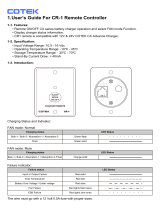
900-0198-01-00 Rev B 3
Table of Contents
Introduction .............................................................................................. 7
Audience ......................................................................................................................................... 7
Symbols Used ................................................................................................................................. 7
Welcome to OutBack Power ........................................................................................................... 8
Inverter Functions ........................................................................................................................... 8
General Safety ................................................................................................................................ 9
Inverter Controls ............................................................................................................................. 9
System Display and Controller .................................................................................................................... 9
On/Off Switch ............................................................................................................................................ 10
Operation ............................................................................................... 11
LED Indicators .............................................................................................................................. 11
Battery Indicators ....................................................................................................................................... 11
Status Indicators ........................................................................................................................................ 12
Inverter Functionality ..................................................................................................................... 12
AC Input Connection ..................................................................................................................... 13
Description of Inverter Operations ................................................................................................ 13
Inverting ..................................................................................................................................................... 13
DC and AC Voltages ............................................................................................................................................. 14
Search .................................................................................................................................................................. 14
Input ........................................................................................................................................................... 15
AC Current Settings .............................................................................................................................................. 16
AC Source Acceptance ......................................................................................................................................... 16
Generator Input ..................................................................................................................................................... 17
Transfer ................................................................................................................................................................ 17
Battery Charging ........................................................................................................................................ 18
Charge Current ..................................................................................................................................................... 18
Charge Cycle ........................................................................................................................................................ 19
Charging Steps ..................................................................................................................................................... 20
New Charging Cycle ............................................................................................................................................. 22
Equalization .......................................................................................................................................................... 23
Battery Temperature Compensation ..................................................................................................................... 23
Multiple-Inverter Installations (Stacking) ................................................................................................... 25
Stacking Configurations ............................................................................................................................ 26
Classic Series Stacking (Dual-Stack).................................................................................................................... 26
OutBack Series Stacking (Dual-Stack) ................................................................................................................. 26
Parallel Stacking (Dual-Stack and Larger) ............................................................................................................ 27
Series/Parallel Stacking (Quad-Stack or Larger) .................................................................................................. 28
Three-Phase Stacking .......................................................................................................................................... 28
Power Save .......................................................................................................................................................... 29
Auxiliary Terminals .................................................................................................................................... 32
System Display-Based Functions (AGS) ...................................................................................... 34
Metering ................................................................................................ 35
MATE3s Screens .......................................................................................................................... 35
Inverter Screen .......................................................................................................................................... 35
Battery Screen ........................................................................................................................................... 36



























